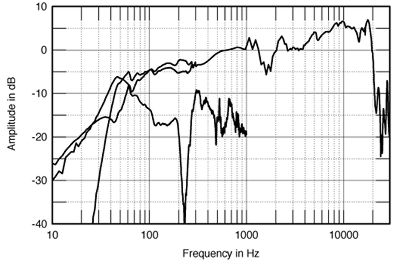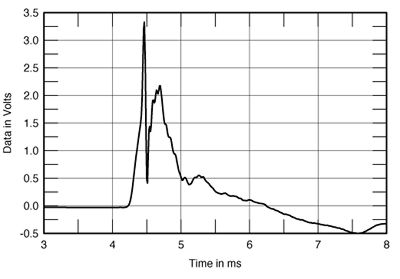| Columns Retired Columns & Blogs |
Odeon La Traviata loudspeaker Measurements
Sidebar 3: Measurements
As expected from its use of a horn-loaded tweeter, the Odeon La Traviata is almost 10dB more sensitive than the average for a direct-radiating design, at an estimated 96.4dB(B)/2.83V/m. It will go immensely loud with only a few amplifier watts, though the downside of this high sensitivity is the need for exceptionally quiet amplifiers and source components. (See, for example, RD's review of the Quicksilver Horn Mono amplifier elsewhere in this issue.)
In addition, the Odeon's plot of impedance magnitude and phase (fig.1) reveals it to be an extremely easy load for an amplifier to drive. As well as an audioband impedance that drops below 8 ohms only in the lower midrange, the speaker's electrical phase angle is high only when the magnitude is also high, which will mitigate the effects of this angle. The one exception is the octave above 25kHz, where the impedance magnitude dips to just above 1 ohm at 42kHz, which is probably just the residual resistance of the wiring. Yes, it's extremely unlikely that there will be any significant energy in this frequency region, but amplifiers that are only marginally stable might not react kindly to this load.

Fig.1 Odeon La Traviata, electrical impedance (solid) and phase (dashed). (2 ohms/vertical div.)
Some small peaks and dips between 180Hz and 500Hz in the impedance magnitude trace suggest the presence of mechanical or acoustic resonances. The undamped cabinet did sound quite lively when subjected to the traditional knuckle-rap test, but investigating the plywood panels' behavior in a more objective manner with a piezoelectric plastic accelerometer revealed only some fairly low-level modes. Fig.2, for example, taken with the accelerometer fastened to the center of the top panel, shows both that some pumping of the panel occurs at the port-tuning frequency of 42Hz, and that some resonant modes are present at 255Hz and 313Hz. These modes could be detected on the other cabinet walls, but they are fairly low in level; in any case, the Traviata's 10dB-higher-than-average sensitivity should lower the audibility of any cabinet problems.

Fig.2 Odeon La Traviata, cumulative spectral-decay plot of accelerometer output fastened to center of top panel. (MLS driving voltage to speaker, 7.55V; measurement bandwidth, 2kHz.)
The notch at 42Hz in the magnitude trace in fig.1 reveals the tuning of the twin ports in the Odeon's base. (These ports are actually rectangular openings—the cover plate was fixed to its rearward, More Bass position for these measurements, with the spikes fitted to give the proper ground clearance.) It can be seen from the traces to the left of fig.3 that there is a notch in the woofer's nearfield response at this frequency, and that the ports' response does peak between 37Hz and 75Hz. As MF noted in his in-room measurements, the Traviata offers useful bass down to around 40Hz, just below the lowest note of the four-string double-bass—though you can see from fig.3 that the complex sum of the woofer and port outputs rolls off steeply below 40Hz.

Fig.3 Odeon La Traviata, anechoic response on horn axis at 50", averaged across 30 degrees horizontal window and corrected for microphone response, with the nearfield woofer and port responses and their complex sum plotted below 300Hz, 1kHz, and 300Hz, respectively.
Note, however, that the ports' output continues up to the 1kHz limit of the measurement and that—as well as peaks at 300Hz, 380Hz, 510Hz, and 675Hz—there is a severe cancellation notch at 230Hz. Because the ports fire down into the rug, this higher-frequency output will probably not affect the Traviata's perceived balance. However, this behavior does indicate that there are acoustic problems inside the cabinet. While, again, the speaker's high-voltage sensitivity will work against these problems having audible consequences, I would have preferred there to be no problems in the first place. And I do note that MF was bothered by a consistent character that afflicted the tonalities of instruments that have rich harmonic content in the same region as these problems—the alto saxophone, for example.
Looking higher in frequency in fig.3, the Traviata's farfield response on its horn axis rises throughout the midrange and treble before rolling off sharply above 20kHz. (The slight on-axis peak above 15kHz is probably the contribution of the horn-loaded supertweeter.) Sit on-axis and the sound will indeed have too much HF content, though in itself this might not necessarily correlate with MF's having found the speaker's tonal balance "blue-light" bright (see below).
More disturbing to me was the suckout in the crossover region between 1250Hz and 2kHz. I initially measured the averaged response on the supertweeter axis, 43" from the ground, but the notch at 1.8kHz was even deeper. And if you look at the family of responses in the vertical plane (fig.4), you can see that the notch doesn't fill in until you sit at least 10 degrees below the horn axis, which places your ears an unrealistically low 2' from the ground. Even then, a notch begins to develop a little higher in frequency.

Fig.4 Odeon La Traviata, vertical response family at 50", from back to front: responses 15 degrees-5 degrees above supertweeter axis, response on supertweeter axis, difference in response 5 degrees-15 degrees below supertweeter axis.
Fig.5 is a similar family of curves revealing the Odeon's behavior in the lateral plane, though this time only the differences between the off-axis responses and the response on the supertweeter axis are shown. The notch deepens off-axis at 1.6kHz, though the horn-loaded tweeter's wide dispersion at the bottom of its passband might well mitigate this behavior. Note that, other than in the 1-2.5kHz region, the contour lines in the graph are evenly spaced. But both the woofer in the octave at the top of its passband and the horn in the octave at the top of its band are quite directional.

Fig.5 Odeon La Traviata, lateral response family at 50", from back to front: differences in response 90 degrees-5 degrees off-axis, reference response on supertweeter axis, differences in response 5 degrees-90 degrees off-axis.
As MF reported, sitting off-axis will bring down the Traviata's top-octave energy. However, because of the horn's wide dispersion around 3kHz, this will still leave the presence region in all but large rooms a little protuberant—and it is energy in the presence region and in the octave above that gives rise to perceived "brightness." Note the narrow band of wider radiation around 17kHz; I suspect that this is the effect of the supertweeter, though it doesn't have as wide a dispersion pattern as I would have expected.
In the time domain, the Traviata's impulse response on the supertweeter axis is shown in fig.6. There is a slight positive-going hump from the woofer, over which is laid a later-arriving sharp up/down impulse from the horn-loaded tweeter. I can't see the supertweeter's output in this graph, unless it contributes to the tweeter's spike. The step response (fig.7) reveals that the horn is set back a little too far for the speaker to be time-coherent, the slow rise of the woofer step starting about 200s before the much faster rise of the tweeter. A reflection can also be seen about 800s after the initial step, which might be from the edge of the horn.

Fig.6 Odeon La Traviata, impulse response on supertweeter axis at 50" (5ms time window, 30kHz bandwidth).

Fig.7 Odeon La Traviata, step response on supertweeter axis at 50" (5ms time window, 30kHz bandwidth).
Finally, fig.8 shows the Traviata's cumulative spectral-decay plot, again taken on the supertweeter axis. The sharp notch in the crossover region can be seen to be followed by some delayed energy, suggesting that it is an interference phenomenon. Two small ridges of delayed energy are evident at 5.1kHz and 10kHz, but the waterfall plot is otherwise fairly clean.

Fig.8 Odeon La Traviata, cumulative spectral-decay plot at 50" (0.15ms risetime).
"Bright," said MF of this speaker's in-room balance, and "bright" is what I would have expected from its measured behavior, and what I heard when I listened to it in Mikey's room, even with the speakers driven by the Dynaco tube amplifier with its mellow top octaves. But what a wealth of recorded detail was revealed by Odeon's La Traviata.—John Atkinson
- Log in or register to post comments




































